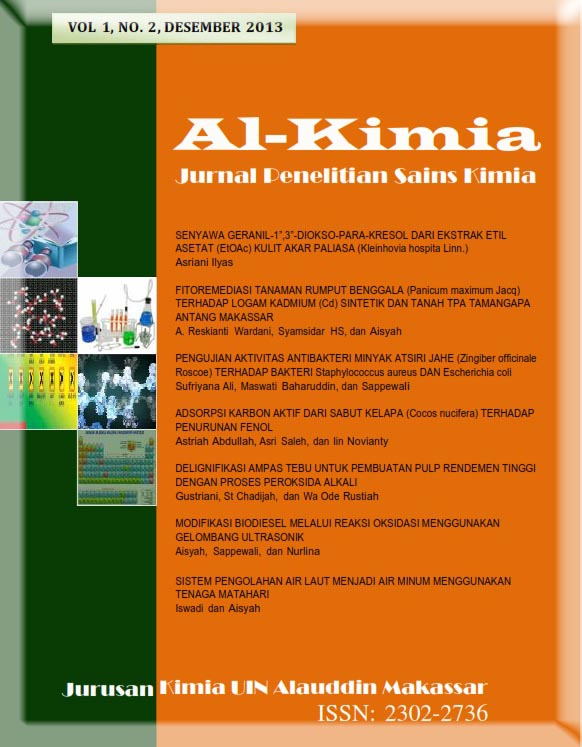Adsorpsi Karbon Aktif dari Sabut Kelapa (Cocos Nucifera) Terhadap Penurunan Fenol
Abstract
Coconut coir can be used as an activated carbon for phenol removal, because of carbon element which is containing in Coconut coir make it to own a potency as an activated carbon. Research on activated carbon adsorption of phenol to the decline of coconut coir (Cocos nucivera) has been performed. This study begins with the dehydration and carbonization stage. Coconut coir activated carbon with 3 activator namely sulfuric acid (H2SO4), sodium hydroxide (NaOH) and zinc chloride (ZnCl2). Coconut coir activated carbon in this study using a variable dose of 500 mg carbon, 1000 mg and 1500 mg. This study aimed to determine the characteristics of the water content, the adsorption capacity of phenol on activated carbon from coconut husk carbon activation results and determine the maximum adsorption capacity of activated carbon from coconut husk carbon in the adsorption of phenol. Activators most good at absorbing phenol is sodium hydroxide (NaOH) with the absorption efficiency of 93.01% at a mass of 1.5 g.
Downloads
References
Amin M., dan Fu’ad A., 2009 Pemanfaatan Limbah Serat Sabut Kelapa Sebagai Bahan Pembuat Helm Pengendara Kendaraan Roda Dua.
Ariyanto, 2010, Investasi Biofuel dari Sabut Kelapa, Jurnal Kimia.
Asbahani, 2013, Pemanfaatan Limbah Ampas Tebu sebagai Karbon Aktif untuk Menurunkan Kadar Besi pada Air Sumur, 13 (1).
Bintang, M., 2010, Biokimia Teknik Penelitian. Edisi I, Cet. I; Jakarta: Erlangga. Departemen Agama RI, 2002, Al-Quran dan Terjemahannya, Semkabon: CV. Asy-Syifa. 2002.
Devina, 2011, Spektrofotometer Serapan UV-Vis, Jakarta.
Fessenden, R. J., dan Fessenden J. S. 1982, Organik Chemistry. Terj. Aloysius Hadyana Pudjaatmaka, Kimia Organik. Jakarta: Erlangga.
Authors who publish with this journal agree to the following terms:
1) Authors retain copyright and grant the journal right of first publication with the work simultaneously licensed under a Creative Commons Attribution License that allows others to share the work with an acknowledgement of the work's authorship and initial publication in this journal.
2) Authors are able to enter into separate, additional contractual arrangements for the non-exclusive distribution of the journal's published version of the work (e.g., post it to an institutional repository or publish it in a book), with an acknowledgement of its initial publication in this journal.
3)Authors are permitted and encouraged to post their work online (e.g., in institutional repositories or on their website) prior to and during the submission process, as it can lead to productive exchanges, as well as earlier and greater citation of published work (See The Effect of Open Access).


